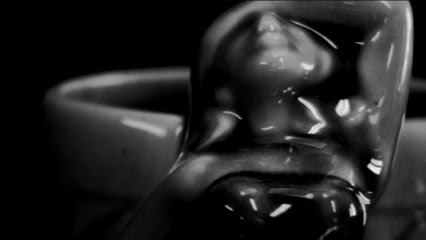At the House of Mr X & User Group Disco
Elizabeth Price
Cinémathèque Robert-Lynen, Paris
Tuesday, April 14th, 2015

User Group Disco, 2009. HD video, 15'. Courtesy of the artist & LUX, London
At the House of Mr. X takes as its subject the home of an anonymous art collector, designed and built in the late 1960s. Only briefly inhabited, the house and its contents remain immaculately preserved. The film opens as a visit to the house. A slow, visual tour begins, proceeding from the entrance through open-plan areas, into every room. The elegant geometry of the spaces, the varied materials of the architecture, and the luxurious modernist furnishings are attentively documented. In particular, the camera dwells upon gleaming, reflective surfaces: the luster of colored glass, bright plastics, and the liquid-shine of chrome. The tour is directed by a silent narrator, present as an on-screen script, punctuated with percussion and close-harmony vocal arrangements. This narrator is the guide for the tour, and the only protagonist in the film. Its script is collaged from documents relating to the house, art collection, and business ventures of the former resident, who generated his wealth through cosmetics brands Outdoor Girl and Mary Quant. The resulting combination of administrative, curatorial and commercial languages produces an equivocal identity: as you move through the pristine interiors the tone shifts from deadpan taxonomical description to the solicitation and innuendo of advertising copy. Your visit provides the only incident interrupting the listless inertia of the house. Under the direction of the Guide, you are ushered through the interiors, invited to enjoy its luxury, exhorted to fully inhabit the exquisite memorial.
User Group Disco is the second work in an ongoing series, in which each episode unfolds a different room within the notional architecture of a fictional institutional building. This video is set in the "Hall of Sculptures," although when the work opens there is nothing there, as the narrator says, that would deserve the name of "sculpture." There is just littered debris: defunct, damaged, unidentifiable things. There are also no people here—no apparent human action, and no visible architecture. The only things visible are the objects themselves—a debris comprised of mundane and ubiquitous objects, utensils and ornaments. And these things drift in a black void. What ensues during the course of the video is a series of reveries and hallucinations concerning these objects. These dwell upon the institution that holds them, upon categories of distinction between art objects and social history artifacts and the strange and compulsive desires of consumerism. They draw upon philosophical and historical materialism, Surrealism and institutional critique to try and understand what objects are, and what they do. The various fantasies of the video are linked together by the recurrence of the image of a spiral or turntable and the material phenomenon of shine, occurring upon surfaces of chrome, vinyl, ceramic and glass. Everything in the video is a bricolage—every image, every text, every desire. The video draws inspiration from the films of Jean Painlevé and of Alain Resnais (mainly The Styrene's Song, 1958, and Even Statues Die, 1953, with Marker) as well as John Carpenter's Assault on Precinct 13 (2005), but is emphatically a video work, exploiting the heterogeneity of that medium to conflate genres of art, fiction, advertising and documentary. The original soundtrack has been composed by Jem Noble. It is also a bricolage of melodies and tunes.
Born in 1966 (UK), Elizabeth Price lives and works in London. She is represented by MOT International (London/Brussels). In 2012, she won the Turner Prize. Her films and installations have been presented in numerous institutions such as the Stedelijk Museum (Amsterdam, 2013), the Baltic Art Center (Newcastle, 2012), the Bielefelder Kunstverein (Bielefeld, 2012), the Chisenhale Gallery (London, 2011) and the New Museum (New York, 2011).
